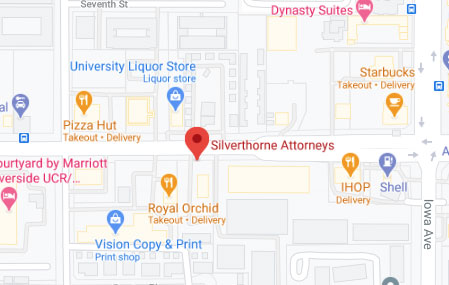
I have been known to get a puncture in almost every tire of every car I have driven (knock on wood that it doesn’t happen to me anytime soon). Which means that I am familiar with riding on a spare until I can get myself to a mechanic. Today, on my way into work, I saw someone on the side of the road putting their spare tire on their car. Naturally that got me thinking, “how long can you really drive on a spare tire?” Working for a car accident lawyer, I want to go over some research I have found about driving on a spare, as well as some tips on changing your tire. If you are suffering from injuries due to the negligent actions of another, contact an auto accident attorney at Silverthorne Attorneys. Consultations are free.
Car Accident Lawyer | The Life of a Spare Tire
Most full-sized spare tires are designed to last anywhere from 7 to 10 years. That being said, you should never use a tire with visible damage. This means that any visible cracks in the sidewall, punctures, impact bulges, or irregular tread-wear are very dangerous to drive on. One thing I have noticed is that some drivers will often rotate their spare with the other tires on their vehicle. From the research I have done, this is advised against.
If your spare tire is in the trunk for too long, it can lose air pressure. Thus making it more dangerous to drive for a substantial amount of time on the spare.
Below, I have listed the different types of spares and how long it is recommend to use them.
Safe-saver/Donut Spares
These spares are ones that are narrow and more compact. and they are designed to save space and weight in a vehicle. a general rule of thumb on these spares is that you should not drive more than 70 miles and no faster than 50mph before replacing the donut spare.
The reason to use these spares for a short period of time is because they have little to no tread on them. This means that the spare will be vulnerable to hazards on the road. It is also much smaller than the other tires on the car, which makes it spin faster in order to keep up with the moving car.
Over those 70 miles, the lubricating grease will break down. Which inevitably will cause unnecessary wear on the gears and clutch plates.
Full-Size Spares
How long do full size spare tires last? Well, that all depends on the quality of the spare. as stated previously, you never want to drive around on spare tires for long. Most full-size spare tires are for SUV’s and any other larger vehicle. So there is no need to worry about the size of the spare being too small for a larger than compact vehicle. While a full-size spares heavier and requires more space for storage, these are quite a bit more durable and can handle a drive similar to a normal tire. in that manner, it is much safer to driver for longer periods of time and greater speeds when you have a full-size spare on your care.
However, you must remember that the spare has not been used to the same extent as the other 3 tires. Which means that your wheel will handle a bit differently which can make it unsafe to drive on it for the long haul. as a car accident lawyer, we always urge people to purchase a new tire as soon as they can. It is better to be safe than sorry.
Run-Flat Tires
Now, this is something new to me. and from the research I have done, run-flat tires are becoming more and more common. Manufacturers are realizing that they cost less to maintain than traditional tires. for example, if you drive a recent model BMW or MINI, your care will most likely came with run-flat tires. These tires are tougher than most tires. However, they are not designed to last forever.
Rather than including a spare tire, these run-flat tires are built to withstand most, if not all, road hazards. Rather than going flat or experiencing a blow-out, a run-flat tire can continue to drive for about 50 miles after a puncture before it needs to be replaced. Note: these tires are more expensive to replace than traditional tires are.
Regardless of the type of spare tire you have, it is in your best interest, for safety purposes, to replace your tire as soon as you can.
Auto Accident Attorney | How to Safely Change a Tire
Below are some helpful tips on how to safely change a flat tire.
Find A Safe Surface
You should always make sure that wherever you change your tire, you are safe. You should have a solid, level surface that will prevent the car from rolling. If you are near a road, park as far from traffic as possible and turn your emergency lights on. If at all possible, avoid soft grounds and hills.
Make sure that you always apply the parking break. If you have a standard transmission, put your car in first or reverse.
Place a heavy object (rock, concrete, spare wheel, etc.) in front of the front and back tires. This will prevent any rolling.
Removing the Hubcap
You want to remove the hubcap and loosen the nuts by turning counterclockwise. However, you do not want to take them all the way off; just break the resistance. by keeping the wheel on the ground when you loosen the nuts, you make sure that you are turning the nuts and not the wheel.
- Make sure that you have the exact socket size for your lug nuts as well as a breaker bar in your trunk just in case.
- It can take a bit of force to break your lug nuts free, so just be patient. If all else fails, you can use your body weight to help. Be careful not to strip the lug nuts.
After this, make sure you pump or crank the jack to lift the tire off the ground. You should lift it high enough so that you can remove the flat tire and replace it with a spare. as you lift, make sure that the car is stable.
Remove the lug nuts the rest of the way by turning them counterclockwise until they are loose.
Remove the Tire
Place the flat tire under the vehicle so in an event of a jack failure, the vehicle will fall on the old wheel. If the jack is placed on a flat, solid base, you shouldn’t have any problems.
- If the tire sticks due to rust, try hitting the inside half of the tire with a rubber mallet to loosen the tire. or you can use the spare tire to hit the outside half.
- Place the spare tire on the hub. Make sure that you align the rim of the spare tire with the the wheel bolts, the put the lug nuts back on.
- Be sure to install the tire the correct way and not backwards. the valve stem of a doughnut tire should face outwards, away from the vehicle.
- If your vehicle uses acorn-style lug nuts, it is easy to put those on backwards. Be sure the tapered part of the nut faces the wheel when tightening.
Tighten The Lug Nuts & Lower The Car
The lug nuts should turn easily at first. You will want to use the wrench to tighten the nuts as much as possible using a star pattern. to ensure that the tire is balanced, don’t completely tighten the nuts on at a time. Going in a star pattern will make sure that each nut is equally tightened.
After this, you want to lower the car without applying full weight on the tire. Lower the car completely to the ground and remove the jack. Finish tightening the nuts and replace the hubcap.
Put the old tire back in the trunk and take it to the mechanic. Get an estimate for the cost of the repair. Small punctures can usually be repaired for less that $15. If the tire is not repairable, they can dispose of it properly and will sell you a replacement.
If you are suffering from injuries due to an accident, please do not hesitate to contact us to discuss your case. Consultations are free.
What To Do When Your Tires Expire
Every morning, I commute from Orange to our office here in Ladera Ranch. Most days, my commute is uneventful and I get to the office without incident… Until this morning! First, I should say that I am not the best driver. I do have a bit of a led foot and find myself driving over the speed limit. Which, I know as the daughter of a mechanic, means that my tires will garner more wear and tear than the “average” driver. So my car crash lawyer thought it would be a good idea write about what to do when your tires blow.
I also, somehow have the tendency to find every nail there is in construction zones and my tires unfortunately pay that price. as I was saying, this morning was a bit of a “to-do” when it came to my usual morning commute. as I was driving I could hear a very low “shhhhhhhhhhh” noise coming from one of my tires. and then all of a sudden a loud… POP! One of my back tires blew. Luckily, I was still in the “slow lane” and was able to move over to the shoulder of the 55 freeway.
I was already in the middle of prime traffic. and though I am no stranger to changing tires, I had never had to change a tire on the freeway. Luckily I have AAA (thanks, mom) – so I called a driver out to put the spare on my car. Fortunately for me, no accidents were caused by my flat. This was because I had enough room to move over to the shoulder.
So, of course as I was waiting for AAA to arrive, I thought that the topic of tire blowouts, how they happen, how to avoid them, and ultimately how to change a tire would be a perfect idea. So here we are!
Most tire blowouts happen during late Spring to early Fall. This is because the temperature is usually the warmest and people have a tendency to drive farther. This combination can push a neglected or worn tire to the point of breaking. Other causes of tire blow outs are:
Underinflation
Air allows the tires to carry to carry the weight of the vehicle, its occupants, and any other cargo. However, without proper air pressure the tire and the components that make up the tire – rubber, fabric, steel, etc. – stretch beyond the tires limits. the very nice AAA gentleman who changed my tire told me to think of it like an old wire clothes hanger. If you manipulate the metal long and far, it will overheat and snap. Driving long distances while having an under inflated tire can have a tremendous affect on the wear and eventual blowout of the tire.
Potholes
This is something that I really should have known about! but I didn’t. a tire can be severely damaged if you slam into a pothole, driveway lip, or any other roadway hazard. Think of freeway construction where there is a lip or a dip in the concrete. the impact can pinch the internal part of a tire and if you hit the pothole or lip hard enough, you may end up cutting or fray the internal part of the tire. It is not an uncommon theme for a pothole to cut all the way through the rubber of the tire and the tire will blow right there.
Slow Death
The slow death of a tire generally refers to the normal wear and tear of a tire that has not been serviced, rotated, or inspected. Underinflation, Overloading (too much weight in the car), potholes, heat, driving long distances at an accelerated speed, all are ways that contribute to the slow death of a tire. You may not see the affects of these right away, but overtime the tire will succumb to the wear and tear and may unexpectedly blow out.
Car Crash Lawyer | Changing A Flat Tire 101
What You Will Need :
- Jack
- Wrench
- Spare Tire
- Flashlight
- Gloves
- Tire Gauge (optional)
- Tire Blocks (optional)
Changing that tire:
- Find a Safe Place to Pull Over: Pull as far over to the shoulder as you can. Make sure not to park your car at the curve of the shoulder where any approaching cars cannot see you. If you can, find a flat spot so that jacking your car up will not be difficult for you. Be sure that your parking brake is set and is you have a manual transmission, leave your car in gear.
- Hazards: Turn your hazard lights on – this is especially important at night.
- Get your jack, wrench, and spare tire from the trunk and set them up (safely) next to the tire that needs replacement
- Use the Wrench to Loosen Lug Nuts: Do NOT remove the lug nuts, simply loosen them by turning the wrench to the left (think righty-tighty, lefty-loosey)
- You may need to remove the hubcap at this time
- Use the Jack to Lift the Car: Once the jack is in the correct spot (reference your owners manual), jack up the car until the tire is at least 6-inches from the ground
- Now Remove the Lug Nuts: Remove the lug nuts and pull the tire straight toward yourself and remove it from the wheel base
- Put the lug nuts in a pile near you – as you will still need them
- Place the Spare Tire on the Car: Line up the lug nut posts with the holes in the spare tire and push the spare all the way onto the wheel base until the tire cannot go any farther.
- Put the Lug Nuts Back On: Don’t screw them on too tightly, but make sure they are secure.
- Lower the Car to the Ground: Use the jack to lower the car back to the ground and remove the jack from underneath the car.
- Make Sure the Lug Nuts Are Tightened: Now that the car is on the ground, you can go ahead and tighten the lug nuts. Tighten opposite lug nuts gradually until each lug nut is as tight as it can be.
- Put the Flat Tire and Tools Back in the Trunk: to keep the roads (and yourself) safe, put all of your tools back in your trunk and do not leave them on the side of the road.
Please also see this step-by-step video on how to change a tire:
[videosingle id=”2629″ width=”100%” height=”400″ rel=”false” /]
In Need Of A Car Crash Lawyer? Contact Us Today!
Safe driving includes making sure that your car is safe to drive as well. Making sure that your pressure is adequate and getting a tune up every three months. Yes, other things can happen that are unexpected.
As a car crash lawyer in Orange County, we see these kinds of things a lot. Luckily, in this instance, an accident was prevented. However, that is not always the case. That is why hiring a car crash lawyer is so important. a car crash lawyer in our firm has the necessary experience when it comes to getting you the settlement you deserve. We will never back down when insurance adjusters are bullying you.
If you or someone you know have been injured in an accident, contact us today. Consultations are free!
How to Fix Your Flat Tire 101
Having a flat tire is one of the most inconvenient things when you are on the road. Especially if you get a flat tire when you are on your morning commute to work. Since I have been doing a lot of driving over the past month or so, I wanted to do a post on how to fix a flat tire. I will not only go over ways to fix your flat but I will also be going over how to change your flat tire. If you are suffering from injuries and you need an auto accident lawyer in Orange County, contact us today. Consultations with a car accident attorney at Silverthorne Attorneys are free!
Auto Accident Lawyer | How to Fix A Flat Tire
Getting a flat tire is such a great inconvenience for anyone. and sometimes, waiting for a tow truck to tow or change the tire can take hours. Below are some easy and practical ways for you to fix the tire until you are able to get a new one.
Finding the Leak
First thing’s first: find where the tire is leaking. If you are not able to see a nail or any other distinctive indictors to show you where the leak is coming from, you want to check for the leak yourself. and the best way to do this is to properly pressurize the tire by inflating it. Inflate your tire with air until it reaches the appropriate pressure (measured in psi) according to your owner’s manual.
After this, you want to listen for any hissing sounds. When air releases from your tires, you will be able to hear what sounds like a hiss coming from the tire. This is helpful, especially when you are not able to see the problem right away. Most tires that are going flat and/or need to be changed will slowly release air. Furthermore, the hissing sound is a clear indication that air is leaking and it will also help you to locate the leak.
On the other hand, if you cannot hear or see where the leak is coming from, feel around your tire. I cannot tell you how many times I feel around my tires just to make sure there aren’t any nails or bubbles.
Fixing the Leak | Option One: Tire Puncture Sealants
There are a few ways that you can fix a tire puncture on your own. Below is one way to fix your leaking tire with tire puncture sealants.
- get the correct sealant and make sure that you read the directions
- many manufacturers have different steps and required amounts you should put in;
- pull out the object that has punctured your tire;
- turn the wheel until the valve is at the top of the wheel
- unscrew the valve cap;
- you will put the sealant in the same way you would put air in your tire;
- unscrew the valve cap;
- attach the nozzle of the product to the valve stem
- once you have the nozzle secure on the valve stem, press the button to release the sealant;
- test it out!
- drive your car to see if the sealant worked;
- you need to rotate the tire in order for the sealant to be evenly distributing;
- moving the tire will also prevent a heavy lump from forming inside of the tire
Fixing the Leak | Option Two: Using A Tire Plug Kit
Your next option is to use a tire plug kit; this is a great step right before changing the tire. We will go over how to change the tire and put a spare on your car below as well.
- loosen the lug nuts with either a tire iron or an impact wrench
- reminder: this is important because if you do not loosen or break the lug nuts, you will not be able to jack up the car;
- the weight of the car will still be on the wheels and will prevent the wheels from spinning dangerously while you turn the lugs
- jack up the car
- once you have loosened the lug nuts, jack up your vehicle so that you can remove the tire;
- do this on level concrete or some other hard, level surface;
- use a floor jack, or a trolley jack;
- use a jack stand to stabilize the car while you are working on the tire;
- finish removing the lug nuts and pull the wheel off the hub;
- pull out any protruding object with a pair of pliers
- mark the spot with chalk or a marker;
- clean the hole with the rasp tool that came in the tire plug kit
- insert the tool in and out of the hole quickly;
- this will roughen the area so the temporary fix will hold;
- insert the tool in and out of the hole quickly;
- thread the plug through the center with your insertion tool
- you may need to squeeze down one end in order to make the thread fit through the hole;
- force plug into hole with the insertion tool
- you should leave at least 1/2″ of the plug protruding from the tire;
- apply rubber cement or glue before inserting plug
- this will lubricate the plug, making it easier to push in;
- cut away excess plug materials from the surface of the tire
- caution: if you use any adhesives, make sure you allow them to dry for at least one minute;
- pump air back into the tire
- use a tire gauge to help check tire pressure as you are pumping air back into the tire;
- apply a soap mixture onto the plug
- this will help to check to make sure that the seal is holding;
- put the wheel back on and lower the car to the ground;
- tighten the lug nuts;
- replace the tire!!
The final step in this is to replace the tire altogether. Because you don’t want to drive on a tire that has had a puncture in it for too long.
Auto Accident Attorney | How to Change a Tire
When you have the time to change your tire or just want to know how to change a tire, you have come to the right place. Working for an auto accident attorney (and being the daughter of a mechanic) has taught me so much about what I need to do in order to take care of my vehicle. and that includes learning how to change a tire on my own.
- find a flat, stable surface that will prevent the car from rolling;
- apply the parking brake and put the car in park;
- place a heavy object in front for the front and rear tires;
- take out the spare and the jack;
- place the jack under the frame, near the tire that you are going to change
- ensure the jack is in contact with the metal portion of the car’s frame
- raise the jack until it is supporting the car (not lifting)
- remove the hubcap and loosen the lug nuts by turning counterclockwise
- don’t take them all the way off yet
- crank the jack to lift the tire off the ground
- crank it enough so that you can remove the tire and put the new one on
- make sure the car is stable as you are lifting the vehicle
- if the car is lifting at an angle or leaning, lower the car and reposition the jack so it will be straight
- remove the lug nuts all the way;
- remove the tire;
- place the tire on the hub and make sure to align the rim of the spare with the wheel bolts;
- put the lug nuts back on;
- tighten the lug nuts by hand until they are all snug;
- lower the car without applying the full weight on the tire;
- lower the car to the ground full and remove the jack;
- put your old tire in the trunk and take it to the mechanic
Injured? Contact a Car Accident Lawyer Today!
Suffering from serious injuries due to an accident can be difficult. That is why you need an auto accident attorney at Silverthorne Attorneys to help guide you. We believe that the only thing you should be focusing on during this time, is getting your health back. That means, that we will take on the burden of your case so you don’t have to. Your car accident lawyer will deal with the insurance adjusters so that you don’t have to. If they are trying to deny your claim or low ball your settlement, we will deal with it. You deserve to be compensated for the injuries you have sustained due to the actions of another.
If you are suffering from injuries, contact a car accident lawyer at Silverthorne Attorneys today. Consultations are free!
How Long Do Spare Tires Last?
I have been known to get a puncture in almost every tire of every car I have driven (knock on wood that it doesn’t happen to me anytime soon). Which means that I am familiar with riding on a spare until I can get myself to a mechanic. Today, on my way into work, I saw someone on the side of the road putting their spare tire on their car. Naturally that got me thinking, “how long can you really drive on a spare tire?” Working for a car accident lawyer, I want to go over some research I have found about driving on a spare, as well as some tips on changing your tire. If you are suffering from injuries due to the negligent actions of another, contact an auto accident attorney at Silverthorne Attorneys. Consultations are free.
Car Accident Lawyer | The Life of a Spare Tire
Most full-sized spare tires are designed to last anywhere from 7 to 10 years. That being said, you should never use a tire with visible damage. This means that any visible cracks in the sidewall, punctures, impact bulges, or irregular tread-wear are very dangerous to drive on. One thing I have noticed is that some drivers will often rotate their spare with the other tires on their vehicle. From the research I have done, this is advised against.
If your spare tire is in the trunk for too long, it can lose air pressure. Thus making it more dangerous to drive for a substantial amount of time on the spare.
Below, I have listed the different types of spares and how long it is recommend to use them.
Safe-Saver/ Donut Spares
These spares are ones that are narrow and more compact. and they are designed to save space and weight in a vehicle. a general rule of thumb on these spares is that you should not drive more than 70 miles and no faster than 50mph before replacing the donut spare.
The reason to use these spares for a short period of time is because they have little to no tread on them. This means that the spare will be vulnerable to hazards on the road. It is also much smaller than the other tires on the car, which makes it spin faster in order to keep up with the moving car.
Over those 70 miles, the lubricating grease will break down. Which inevitably will cause unnecessary wear on the gears and clutch plates.
Full-Size Spares
How long do full size spare tires last? Well, that all depends on the quality of the spare. as stated previously, you never want to drive around on spare tires for long. Most full-size spare tires are for SUV’s and any other larger vehicle. So there is no need to worry about the size of the spare being too small for a larger than compact vehicle. While a full-size spares heavier and requires more space for storage, these are quite a bit more durable and can handle a drive similar to a normal tire. in that manner, it is much safer to driver for longer periods of time and greater speeds when you have a full-size spare on your care.
However, you must remember that the spare has not been used to the same extent as the other 3 tires. Which means that your wheel will handle a bit differently which can make it unsafe to drive on it for the long haul. as a car accident lawyer, we always urge people to purchase a new tire as soon as they can. It is better to be safe than sorry.
Run-Flat Tires
Now, this is something new to me. and from the research I have done, run-flat tires are becoming more and more common. Manufacturers are realizing that they cost less to maintain than traditional tires. for example, if you drive a recent model BMW or MINI, your care will most likely came with run-flat tires. These tires are tougher than most tires. However, they are not designed to last forever.
Rather than including a spare tire, these run-flat tires are built to withstand most, if not all, road hazards. Rather than going flat or experiencing a blow-out, a run-flat tire can continue to drive for about 50 miles after a puncture before it needs to be replaced. Note: these tires are more expensive to replace than traditional tires are.
Regardless of the type of spare tire you have, it is in your best interest, for safety purposes, to replace your tire as soon as you can.
Auto Accident Attorney | How to Safely Change a Tire
Below are some helpful tips on how to safely change a flat tire.
Find a Safe Surface
You should always make sure that wherever you change your tire, you are safe. You should have a solid, level surface that will prevent the car from rolling. If you are near a road, park as far from traffic as possible and turn your emergency lights on. If at all possible, avoid soft grounds and hills.
Make sure that you always apply the parking break. If you have a standard transmission, put your car in first or reverse.
Place a heavy object (rock, concrete, spare wheel, etc.) in front of the front and back tires. This will prevent any rolling.
Removing The Hubcap
You want to remove the hubcap and loosen the nuts by turning counterclockwise. However, you do not want to take them all the way off; just break the resistance. by keeping the wheel on the ground when you loosen the nuts, you make sure that you are turning the nuts and not the wheel.
- Make sure that you have the exact socket size for your lug nuts as well as a breaker bar in your trunk just in case.
- It can take a bit of force to break your lug nuts free, so just be patient. If all else fails, you can use your body weight to help. Be careful not to strip the lug nuts.
After this, make sure you pump or crank the jack to lift the tire off the ground. You should lift it high enough so that you can remove the flat tire and replace it with a spare. as you lift, make sure that the car is stable.
Remove the lug nuts the rest of the way by turning them counterclockwise until they are loose.
Remove the Tire
Place the flat tire under the vehicle so in an event of a jack failure, the vehicle will fall on the old wheel. If the jack is placed on a flat, solid base, you shouldn’t have any problems.
- If the tire sticks due to rust, try hitting the inside half of the tire with a rubber mallet to loosen the tire. or you can use the spare tire to hit the outside half.
- Place the spare tire on the hub. Make sure that you align the rim of the spare tire with the the wheel bolts, the put the lug nuts back on.
- Be sure to install the tire the correct way and not backwards. the valve stem of a doughnut tire should face outwards, away from the vehicle.
- If your vehicle uses acorn-style lug nuts, it is easy to put those on backwards. Be sure the tapered part of the nut faces the wheel when tightening.
Tighten The Lug Nuts & Lower The Car
The lug nuts should turn easily at first. You will want to use the wrench to tighten the nuts as much as possible using a star pattern. to ensure that the tire is balanced, don’t completely tighten the nuts on at a time. Going in a star pattern will make sure that each nut is equally tightened.
After this, you want to lower the car without applying full weight on the tire. Lower the car completely to the ground and remove the jack. Finish tightening the nuts and replace the hubcap.
Put the old tire back in the trunk and take it to the mechanic. Get an estimate for the cost of the repair. Small punctures can usually be repaired for less that $15. If the tire is not repairable, they can dispose of it properly and will sell you a replacement.
If you are suffering from injuries due to an accident, please do not hesitate to contact us to discuss your case. Consultations are free.
Squeaky Tires? Here Are Reasons Why!
I recently bought a new car and like I have said before, I commute to work. I put roughly 310 miles on my car from my commute alone. So this morning, as I was making a u-turn, I noticed that my tires make a screeching noise. Now, I am the daughter of a mechanic and working for an accident attorney, I know that it is important to pay attention to every sound, smell, everything that may be different about your car. and working for a car accident lawyer, I thought it would be a good idea to do some research on why my tires were squeaking. Below are some reasons why your tires may screech or squeak. If you are suffering from injuries, do not hesitate to contact an accident attorney in our office.
Accident Attorney | Tire Squeals & Turning
There are a few common reasons why tires squeal when turning corners. Those reasons include:
- Underinflation;
- Worn or uneven tread;
- Wheels are misaligned;
- There is an issue with the wheel, steering, and/or suspension.
I do want to note that tires have the tendency to also squeal when making a u-turn or making any sort of tight turn if the roads are wet and there is not enough traction on the roads for your tires to grip.
Underinflation
If there is a squeak or squall in one front tire when you are turning tight corners, check your tire pressure. Under-inflated tires are the key reason for most squealing. Make sure you are checking your owner’s manual for the recommended tire pressure, then inflate if need be. It is also handy to have a tire pressure gauge on hand. I always recommend keeping a small tool box in the trunk of your car. Most tool boxes include air pressure gauges. If yours does not,
Worn Or Uneven Tread
My old car had so many problems with the tread. and I will be honest, I do drive a bit fast. However, tire tread is what provides you with enough traction. and when there is a lack of tread it makes the tires squeal when turning corners. Especially tight corners. Tires are legally considered bald and dangerous at 2/32″ tread depth. However, it is possible to notice traction loss at 5/32″.Uneven wear can make your tires squeal much sooner. Only a portion of the tire wears prematurely when this is the case. Uneven tire wear can also indicate issues with alignment, wheel and suspension part damage or wear, etc. to avoid uneven wear, make sure you are checking the balance of your tires and rotate your tires to achieve proper weight distribution.
Wheel Misalignment
If the camber and toe settings goes off, the tires may start to wear unevenly and touch the road at the wrong angle. This can cause all sorts of noises in your car.Your suspension position may be thrown off when you hit a large curb, pothole, etc. It is important to note that your wheel alignment is different than tire balancing. One is suspension positioning, while the other is weight distribution within your tires.
Non Tire Related Issues
There are a few non-tire-related issues behind why there may be a squeal or screech when turning your wheel. Some of those are:
- Damaged Belt – If the squealing increases when you are turning corners at a faster speed, the engine belt may be worn or damaged. It may become one of the causes of the power steering pump to malfunction.
- The main sign of a damaged belt is a heavy steering wheel.
- Faulty Wheel Bearing – Faulty or worn out bearings or axle can create the friction that causes a squealing sound. Bearings act like a pillow between the axle and wheel so if you do not change them regularly, they may cause a grinding sound.
- Dry Steering/Suspension – If steering or suspension needs lubrication, they may make a sound like a tire squeal when turning corners.
- Low Power Steering Fluid – If you hear a tire squeal when turning corners, this could be due to lack of power steering fluid. in this case, the noise will come out once you turn the steering wheel. Check for any leaks that may look pink or red.
Accident Attorney | Simple Solutions
This article isn’t to scare anyone. but to inform you. and there are simple solutions to these issues.
- Regular tire pressure checks;
- Proper tire maintenance routine;
- Proper vehicle maintenance routine.
We know that suffering from injuries due to an unexpected event is very stressful. That is why we are here to help. a car accident lawyer in our firm wants you to know that you are not alone. as your accident attorney, we believe that you deserve the time to heal from your injuries. You should not have to deal with the insurance companies who will likely give you the run around or leave you out in the cold. If you are suffering from injuries, please do not hesitate to contact us. Consultations with an attorney in our office are free!












